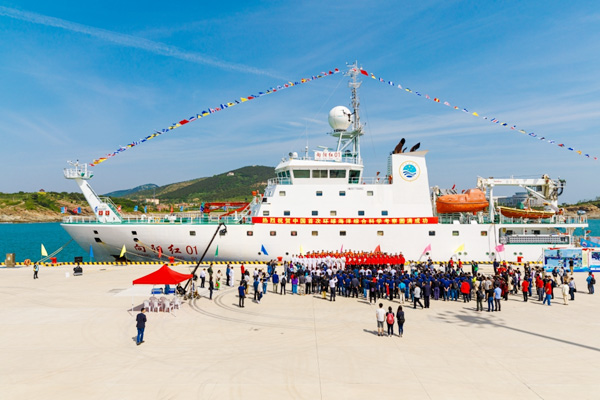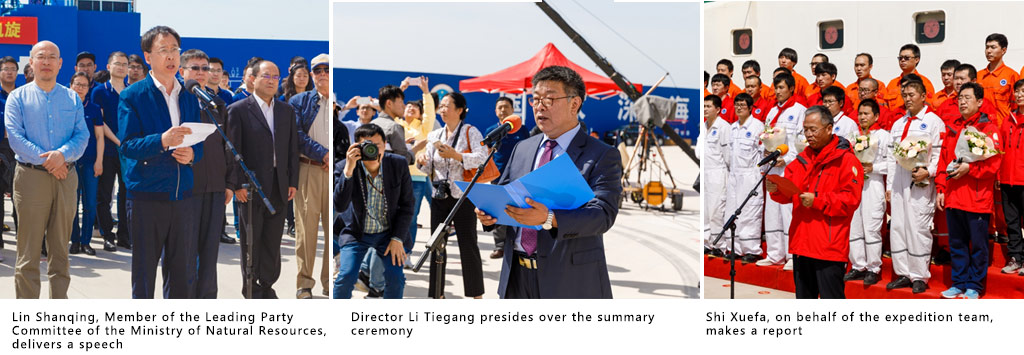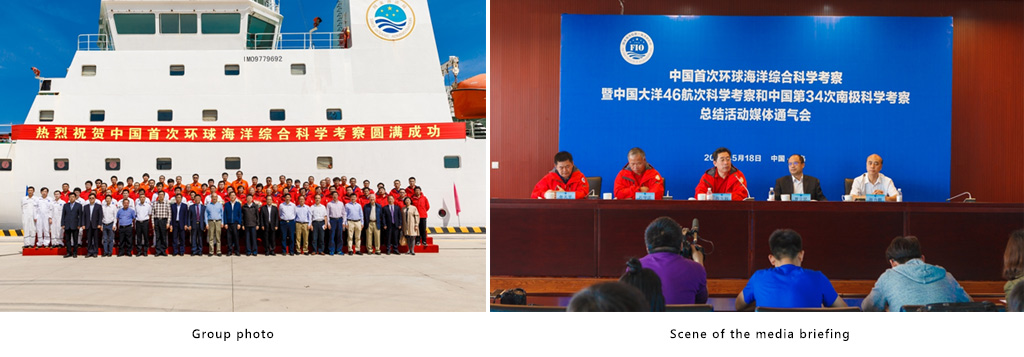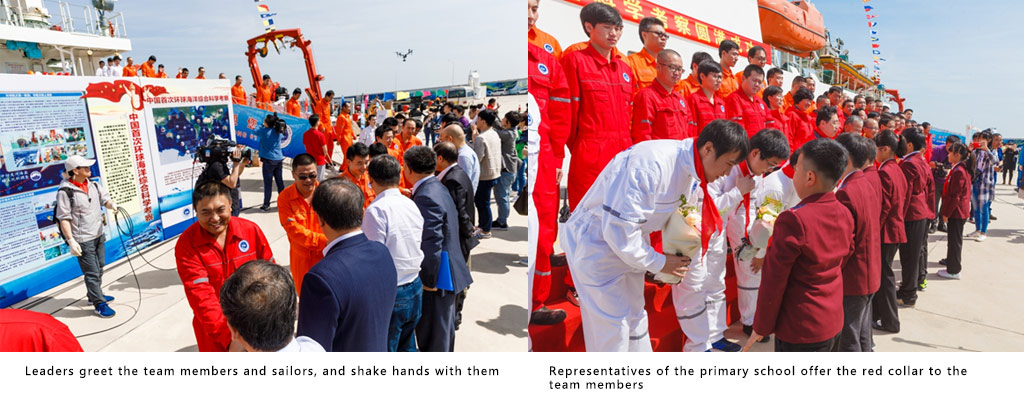“Xiang Yang Hong 01” Returns in Triumph after the First Around-the-World Integrated Marine Scientific Investigation
—Covering a range of 38,600 nautical miles and creating numerous “firsts” for marine scientific investigation
 Scene of Summary Ceremony |
On May 18, “Xiang Yang Hong 01”, China’s new-generation vessel for integrated marine scientific investigation with all-weather observing capacity in non-restricted waters, successfully finished China’s first around-the-world integrated marine scientific investigation, and returned to Qingdao, Shandong. The ceremony for the summary of the scientific investigation mission was attended by Lin Shanqing, Member of the Leading Party Group of the Ministry of Natural Resources, the leaders of the First Institute of Oceanography (FIO) of the State Oceanic Administration (SOA)—the organizer of the voyage, as well as the leaders of units involved in the voyage. Director Li Tiegang presided over the ceremony, during which Shi Xuefa, Chief Scientist of China’s 46th oceanic scientific expedition, made a report on behalf of the team.
After the activity, the “China’s First Around-the-World Integrated Marine Scientific Investigation” and the “Media Briefing for the Summary of China’s 46th Oceanic Scientific Expedition and China’s 34th Antarctic Scientific Expedition” were held. Zhang Liqun, Deputy Director of the Publicity and Education Center of SOA, presided over the briefing. Attendees included Qiao Fangli, Temporary Party Committee Secretary of the Around-the-World Expedition and Party Committee Secretary of the FIO, Xia Limin, Deputy Director of the Chinese Arctic and Antarctic Administration (CAA), Shi Xuefa, Chief Scientist of China’s 46th oceanic scientific expedition, and Zhang Zhiping, Captain of the Around-the-World Expedition, all of who also answered questions from relevant media.
China’s first around-the-world integrated marine scientific investigation, aimed at implementing the Maritime Power Strategy, is the first multidisciplinary and integrated investigation combined with resources, environment and climate around the world during the “13th Five-Year Plan” period. It is also the first integrated marine investigation of “Xiang Yang Hong 01” after its delivery.
China’s first around-the-world integrated marine scientific expedition consists of China’s 46th oceanic scientific expedition (the first, second, third, fifth and sixth leg) and China’s 34th antarctic scientific expedition (the fourth leg), including 25 participating units and 183 sailors. “Xiang Yang Hong 01” departed from Qingdao on August 28, 2017, and after crossing the India Ocean, the South Atlantic Ocean, and the entire Pacific Ocean, it has finished a 263-day voyage with a range of 38,600 nautical miles (over 71,000 kilometers). With the successful completion of numerous missions for scientific investigation in oceans and Polar Regions, this expedition has realized high resources-environment-climate integration, and made several breakthroughs. As a significant practice of “accelerating the construction of the Maritime Power”, it has opened a new chapter of China’s deep-sea scientific investigation in history.
I. Accomplishments of All-Leg Scientific Research
1. Achieve Results in Both Rare Earth Resources and Environmental Investigation in the Indian Ocean
China is the only country worldwide that has found vast deposits of rare earth minerals on the floor of the Indian Ocean. During the first leg of the expedition, the FIO has carried out dense investigation of the deep-sea rare earth minerals in the Central Indian Ocean Basin (CIOB) in bad sea conditions. In the ultra-normal enrichment zone of rare earth minerals discovered earlier, it has found a core area for ultra-normal enrichment of rare earth minerals, and precisely estimated the resource potential in the prospecting area of CIOB, deepening the understanding of rare-earth distribution and metallogenic regulation there. China, therefore, has become the strongest one to investigate and study the deep-sea rare earth minerals in the Indian Ocean.
During the expedition, the FIO has implemented multidisciplinary integrated surveys of hydrometeorology, geophysics, bioecology, and microplastics in investigated areas, deployed “Bai Long” (White Dragon), a buoy researched and developed independently by China, and also collected valuable samples and information, providing important data for the assessment of marine environment, biological ecology and climate change in the Indian Ocean.
2. Make Major Breakthroughs in Volcanogenic Massive Sulphide Ore Deposits (VMS Ore Deposits) in the South Atlantic Ocean
China has found and named a majority of hydrothermal areas and anomalies in the mid-ridge of the South Atlantic Ocean. During the second and third legs, the FIO has conducted a detailed investigation of VMS ore deposits in the 700-kilometer-long mid-ridge of the South Atlantic Ocean, with major breakthroughs made. Besides discovering numerous mineralization anomalies in the investigated area, the FIO has obtained vast samples of VMS ore deposits, including large-sized hydrothermal chimneys and three-ton massive sulfides. For this reason, China has become the country which has the highest degree of investigation and study of VMS ore deposits in the South Atlantic Ocean. Since polymetallic nodules have been founded in the Cape Basin of the South Atlantic Ocean, the sampling, along with the data from the towed body for the shooting indicates that the Cape Basin has a certain potential of polymetallic nodule resources.
The FIO has carried out three-dimensional and multidisciplinary integrated environment surveys of hydrometeorology, seawater chemistry and bioecology in a systematic way in the mid-ridge of the South Atlantic Ocean. It has also made the following results: implementing hydrological surveys across the Atlantic Ocean and obtaining the data of hydrological sections across the South Atlantic Ocean; conducting microplastic surveys in the South Atlantic Ocean and detecting the existence of marine microplastics; finding a large area of abundant benthos like sponges and corals in the seamounts of Atlantic Arks, and a lot of such hydrothermal organisms as hydrothermal fish, blind shrimps, crabs and sea anemones on Xunmei Hill, and revealing spatial distribution law and basic characteristics of deep-sea organisms in the South Atlantic Ocean.
3. Create a New Record in the Antarctic Science Investigation
“Xiang Yang Hong 01” and “Xue Long” have co-conducted China’s 34th Antarctic scientific expedition in the Antarctic Ocean. It is the first time to combine oceanic and polar scientific investigation, and “check” large areas of the Atlantic sector of the Antarctic (hereinafter referred to as “the sector”) which is relatively weak in China’s Antarctic scientific investigation. Thus the FIO has created a number of “firsts”: (1) expanding China’s Antarctic scientific investigation to the sea areas of 37° W from the traditional 45° W; (2) successfully completing two-station observation of integrated marine environmental factors in the middle passage, during crossing the Drake Passage; (3) deploying two sets of deep-sea buoys in the Powell Basin of the Antarctic, and creating a new chapter of China to conduct long-term observation in the sector through the subsurface buoy; (4) carrying out a wide range of full-coverage bottom topographic surveys in the sector; (5) implementing the 480-channel high-resolution multichannel seismic detection in the sector; (6) carrying out in-situ heat-flow measurements in such special geological structural units as submarine hydrothermal solutions and cold seep activities in the Antarctic Ocean; (7) using the underwater in-situ sediment acoustic measurement system with the independent intellectual property right, and obtaining the sediment acoustic characteristic parameters at three stations with different sediment environments; (8) realizing a multi-parameter inversion combined with gravity, magnetism and seismicity in the sector; (9) finding the direct geological and geophysical evidence that the formation of gas hydrates in the investigated area is closely related to the seafloor hydrothermal activity; (10) conducting the sectional and systematic investigation of ecological characteristics of the edge of the ice and the island, and getting the sectional scenery of different deep benthos along with their living environment; (11) systematically observing such large marine mammals as the Cetacea in the sector and discovering the dense distributing area of the Cetacea like the humpback whale which has great protection and research value; (12) finding the existence of marine microplastics in the sector.
4. Find Large Areas of Rich Deposits of Rare Earth Minerals in the Southeast Pacific Ocean
During the fifth and sixth legs, the FIO has made a preliminary selection of an area of about 1.5 million square kilometers of rich deposits of rare earth minerals in the deep Southeast Pacific Basin. It is the first time to discover large areas of rich deposits in that sea area, breaking a new record for the investigation of domestic and international deep-sea rare earth resources. China, therefore, has become the strongest country to investigate and study the deep-sea rare earth resources in the Southeast Pacific Ocean. The FIO has also collected abundant samples of deep sea polymetallic nodules in the Southeast Pacific Basin.
In the aspect of hydrometeorology, the FIO has obtained all-element hydrometeorological data from the height of 10,000 meters to the bottom boundary layer, carried out a mixture of meticulous scientific experiments caused by surge, and focused on turbulence problems troubling the world to gain the core data generated by turbulence. It has discovered such suspected microplastics as fiber, particles and debris at numerous stations in the Southeast Pacific Ocean. In the aspect of ocean chemistry and bioecology, the FIO has systematically acquired the bioecological data in the investigated area and expedition area, helping to fill in the information gap of China in this region.
As for the application of new technology, the FIO has collected the information of plankton in the sea area by using the Video Plankton Recorder (VPR) in China for the first time. It has successfully deployed and recycled the underwater glider (assembling turbulence meter) made in China, which is the first time to implement turbulence investigation through the home product in the ocean. During the instigation, it has conducted the collaborative operation between geological sampling and hydrological investigation by the Conductivity Temperature Depth (CTD) in an innovative way, greatly improving the working efficiency.
II. Significance and Impact of the Around-the-World Expedition
The integrated marine scientific investigation of “Xiang Yang Hong 01” around the world has realized the high integration of all Marine resources, environment and climate. During the six legs, the FIO has successfully over fulfilled the design task in a safe and smooth way, and made a series of fruitful research results.
For the submarine resources, the FIO has deepened the understanding of the distribution range and metallogenic regulation of the rich deposits of rare earth minerals in the Indian Ocean and the Southeast Pacific Ocean, and found the distribution range and metallogenic regulation of VMS ore deposits in the South Atlantic Ocean, laying a solid foundation for China to comprehensively implement international seabed area activities in the three oceans, and expanding the new space of resource exploration in China.
For the marine environment, this expedition covers the key area of ocean resources development in China, the continental shelf of the Antarctic Peninsula, as well as the high-density and high-incidence areas of oceanic microplastics, oceanic anoxic zones and ocean acidification along the voyage, during which the FIO has carried out the investigation and research related to marine ecology and environment, providing important scientific support for the future exploitation of resources, the protection of deep-sea ocean, the maritime delimitation of the Antarctic continental shelf and the improvement of China’s global marine environmental governance capability.
For the ocean and climate, since this expedition has crossed numerous monsoon systems, including the East Asian monsoon, the South Asian monsoon, the African monsoon and the Australian monsoon, the FIO has explored the interconnection process and mechanism among monsoon systems, the monsoon and the ocean current, as well as the high and low latitude degrees, to seek a layout worldwide for China’s marine climate and ocean forecasting, and serve the construction of the Maritime Silk Road.
For the international cooperation, when the scientific research vessel of “Xiang Yang Hong 01” berthed in Punta Arenas, Chile, after finishing the fourth leg, the representative of the FIO who participated in the expedition signed the Memorandum of Understanding Concerning the Implementation of the Scientific Cooperation between the Antarctic and the Southern Ocean with the Chilean Antarctic Institute, helping China-Chile scientific cooperation of the oceans and Polar Regions step into a new stair. When the vessel berthed in the port of Papeete during the fifth and sixth legs, the FIO conducted close exchanges with representatives of government officials, including the Minister of Education of French Polynesia. Successful international exchanges have manifested China’s ability and level of the scientific investigation and research in oceans and polar regions, and meanwhile popularized the friendly idea—“Towards a Community of Common Destiny” adhered by China’s institutes of oceanography.
For the marine popularization of science, scientists involved in this expedition have held two special open courses online in the legs of the Antarctic and the Pacific Ocean. The courses have been released worldwide via media, giving the public the most vivid ocean knowledge, and arousing their enthusiasm for caring and loving ocean.
The scientific investigation of “Xiang Yang Hong 01” around the world focuses on the Southern Hemisphere where humans have relatively weak understanding, filling in the gaps of several sea surveys. The FIO has made fruitful results with numerous “firsts”, and successfully over fulfilled various scientific investigation missions. Through this systematic and integrated multidisciplinary scientific investigation, the FIO has realized the high resources-environment-climate integration, accumulated abundant data for further exploring ocean mystery, expanding the space of exploring seabed resources, and further implementing the research on the role of oceans in global climate change, and the latest global marine environmental hot issues, and channeled new power and energy into the rapid and healthy development of marine science in China.
|





